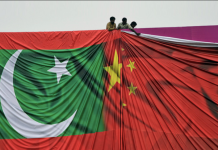ISLAMABAD: Pakistan has welcomed Singaporean firms to explore
and participate in new investment opportunities in its various sectors,
including digital economy, fintech, and agro-food, as well as CPEC related
Special Economic Zones (SEZs), WealthPK reported.
Since 2001, trade with Pakistan has tilted hugely in favour of Singapore,
according to WealthPk analysis. Singapore’s exports to Pakistan totalled
USD778.24 million in 2019, while imports from Pakistan reached USD190.02
million, resulting in a USD968.26 million trade volume.
Owing to global constraints, trade volume dropped to USD648.81 million in
2020. It, however, increased to USD693.82 million in October 2021 with an
increase of USD45 million (6.93 percent).
In exchange for imports of textiles, textile goods, mineral fuels, and
pharmaceutical products, Singapore primarily exports mechanical appliances,
mineral fuels, and electrical machinery to Pakistan.
To increase trade volume, Pakistan and Singapore held virtual trade
consultations at the end of January 2022 during which they discussed the
full range of bilateral relations, including economic, defense, science &
technology, vocational training, academic, and tourism cooperation.
The respective meetings were headed by Asim Iftikhar Ahmad, Additional
Secretary (Asia-Pacific), and Ng Teck Hean, Deputy Secretary (Asia Pacific,
and Southeast Asia) of the Ministry of Foreign Affairs of Singapore.
Complementarities and possibilities of service trade were also discussed,
WealthPK reported.
China and Singapore are the biggest trading partners in the region.
According to Chinese official figures, Singapore received 23% of all
BRI-related external investment and 85% of BRI-related internal investment.
Singapore is also one of the most important RMB trading centres in the
world.
As a result, it is ideally positioned to serve as the chosen centre for
large regional infrastructure projects resulting from the BRI.
Pakistan’s gateway to Southeast Asia is Singapore.
With over 500 million customers, the region is a growing market. Pakistani
enterprises have a clear chance to export more to Southeast Asia. Germany’s
Brandenburg has established centres in Singapore to showcase their products
and assist their businesses in reaching out to the region. Pakistani
businesses may do the same, leveraging Singapore’s strategic position and
skills to advertise their products across Southeast Asia.
Gwadar port, like Singapore port, is located at a crossroads of the
East-West and North-South, providing competitive advantages to its users.
This fact should be leveraged to promote it by the CPEC, BRI, and, more
importantly, Pakistani foreign outposts (diplomats) worldwide through
presentations, discussions, and hosting seminars to steamship lines and
freight brokers exporters, and multinationals.
Gwadar Port represents a golden opportunity for Pakistan to turn itself into
a rich nation in the region by pursuing a path of strong economic growth,
better-paying employment, and establishing a permanent supply of urgently
needed foreign remittances. The port has been designated as the CPEC’s
flagship project under BRI. As a result, similar to Singapore’s and
Shenzhen’s ports, this will serve as a springboard for Pakistan’s growth and
prosperity.
The Special Economic Zones projects under CPEC will be completed in four
phases and will be completely operational by 2030, playing a critical role
in the country’s economic growth. The government should promote SEZs and
CPEC opportunities in terms of business to government, business to business,
exhibitions, technological vocational training, and trade delegation
exchanges, as their execution would undoubtedly improve trade volume and
boost exports between Pakistan and Singapore.
Furthermore, to alleviate the overall trade balance, new technology and
manufacturing processes must be utilized in the domestic market to boost
effective resource allocation, output, and exports.
In addition, those industries operating well should be adequately protected
from international competition, resulting in the growth of the domestic
industry over time. -INP






